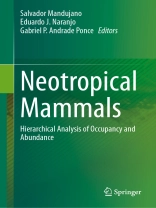This book reviews and synthesizes studies on local and regional occupancy and abundance of Neotropical mammals from central Mexico to South America. The book focuses primarily on addressing issues of a wide array of mammalian species from a population level in different habitats and ecosystems across the Neotropical region. Occupancy and abundance analyzed through hierarchical approaches with a variety of statistical tools are the central ecological parameters treated in the chapters of this volume. This book will be an updated reference for researchers, professionals, students, wildlife managers, and people interested in mammal ecology and conservation in tropical and subtropical regions.
สารบัญ
Part I. Literature reviews.- 1. Introductory issues on hierarchical analysis of occupancy and abundance of the Neotropical mammals.- 2. Small wild felids of South America: A review of studies, conservation threats and research needs.- 3. Patterns of occupancy and density of the small felids of tropical America.- 4. ales from southern Brazil: hierarchical modeling of occupancy, abundance, and density of Atlantic Forest and Pampa mammals.- 5. Modelling the abundance and spatial distribution of the guanaco (Lama guanicoe) in Patagonia: a review and future perspectives.- 6. Survey methods and hierarchical modeling for Mexican primates.- 7. Abundance, density, and occupancy of ungulates in the Maya Forest: A review.- Part II. Case studies.- 8. Factors influencing habitat occupancy by the spotted paca (Cuniculus paca) in Oaxaca, Mexico.- 9. Jaguars (Panthera onca) in the Llanos of Colombia and Venezuela: estimating distribution and population size by combining different modellingapproaches.- 10. Using camera trap data to simultaneously estimate jaguar (Panthera onca) density and resource selection in the Paraguayan Dry Chaco.- 11. Abundance of Coimbra-Filho’s titi monkey in the Atlantic Forest, Brazil: use of N-mixture models for acoustic playback survey data.- 12. Modeling density and habitat preference of the mountain tapir (Tapirus pinchaque) in northern Peru using spatial mark-resight and occupancy models.- 13. Interweaving scientific and local ecological knowledge through studying the salience of wild mammals in two protected areas in the Monte ecoregion of Argentina.- 14. Occupancy modeling reveals that landscape-scale drive habitat use by white-tailed deer in the Tehuacán-Cuicatlán Biosphere Reserve, Mexico.- 15. Overview of hierarchical models and future directions in the study of Neotropical mammals.
เกี่ยวกับผู้แต่ง
Salvador Mandujano is a Senior Researcher in the Red de Biología y Conservación de Vertabrados at Instituto de Ecología A.C., México. He is a member of Mexico’s Researchers National System (SNI-II). Has a degree in Biology from the Universidad Autónoma Metropolitana Unidad Xochimilco, and Master’s and Ph D in Biological Sciences from Universidad Nacional Autónoma de México. His main research interests include population ecology, conservation, and management of mammals, especially ungulates (white-tailed deer, brocket deer, and collared peccary) in dry tropical forests. He is particularly interested in current methodologies for the assessment of distribution and abundance at different spatial (metapopulation models) and temporal (demographic models) scales using various techniques including photo-trapping and quantitative data analysis in the R program. Other interests include population viability analyses in fragmented landscapes, deer-livestock interactions, training workshops for sustainable use in extensive UMAs and protected areas, and dissemination of scientific information through different media.
Eduardo J. Naranjo received a Ph.D. in Wildlife Ecology and Conservation at the University of Florida, Gainesville in 2002, and a Master’s in Wildlife Management at Costa Rica’s Universidad Nacional in 1994. He has been a Senior Researcher in the Department of Biodiversity Conservation at El Colegio de la Frontera Sur (Chiapas, Mexico) since 1995. He was faculty in Biology at the Universidad de Ciencias y Artes de Chiapas, Mexico for 34 years, and has been a visiting professor in universities of Canada, Costa Rica, Peru, USA, and UK. He was president of the Mexican Association of Mammalogists (AMMAC, 2004-2006), and is a member of the IUCN Tapir and Peccary Specialist Groups, and Mexico’s Researchers National System (SNI). His research interests include wildlife population ecology, management, sustainable use, and conservation in Neotropical forests.
Gabriel P. Andrade-Ponce is a Colombian biologist who obtained his Bachelor’s degree in Biology from the National University of Colombia. He further pursued a Master of Science degree at the Institute of Ecology A.C. in Xalapa, Mexico, and is currently a Ph D student at the same institution. He was honored with the Mexican Association of Mammalogy (AMMAC) award for the best master’s thesis in the 2020 edition. His research primarily focuses on the application of statistical models to address ecological questions, particularly using mammals and camera trap data. He has a keen interest in ecological interactions, population ecology, the diversity of carnivorous mammals, and the utilization and interpretation of hierarchical models. His current work aims to evaluate the factors influencing carnivorous mammals’ spatial and temporal co-occurrence and their associations with ecological interactions.












